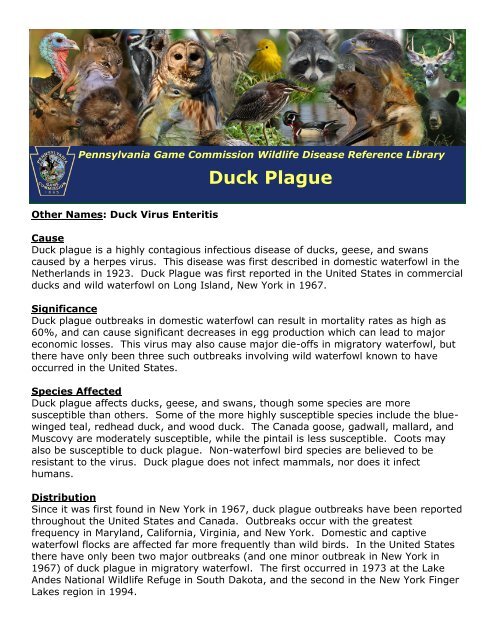Duck Plague
Duck Plague
Duck Plague
Create successful ePaper yourself
Turn your PDF publications into a flip-book with our unique Google optimized e-Paper software.
Pennsylvania Game Commission Wildlife Disease Reference Library<br />
Other Names: <strong>Duck</strong> Virus Enteritis<br />
<strong>Duck</strong> <strong>Plague</strong><br />
Cause<br />
<strong>Duck</strong> plague is a highly contagious infectious disease of ducks, geese, and swans<br />
caused by a herpes virus. This disease was first described in domestic waterfowl in the<br />
Netherlands in 1923. <strong>Duck</strong> <strong>Plague</strong> was first reported in the United States in commercial<br />
ducks and wild waterfowl on Long Island, New York in 1967.<br />
Significance<br />
<strong>Duck</strong> plague outbreaks in domestic waterfowl can result in mortality rates as high as<br />
60%, and can cause significant decreases in egg production which can lead to major<br />
economic losses. This virus may also cause major die-offs in migratory waterfowl, but<br />
there have only been three such outbreaks involving wild waterfowl known to have<br />
occurred in the United States.<br />
Species Affected<br />
<strong>Duck</strong> plague affects ducks, geese, and swans, though some species are more<br />
susceptible than others. Some of the more highly susceptible species include the bluewinged<br />
teal, redhead duck, and wood duck. The Canada goose, gadwall, mallard, and<br />
Muscovy are moderately susceptible, while the pintail is less susceptible. Coots may<br />
also be susceptible to duck plague. Non-waterfowl bird species are believed to be<br />
resistant to the virus. <strong>Duck</strong> plague does not infect mammals, nor does it infect<br />
humans.<br />
Distribution<br />
Since it was first found in New York in 1967, duck plague outbreaks have been reported<br />
throughout the United States and Canada. Outbreaks occur with the greatest<br />
frequency in Maryland, California, Virginia, and New York. Domestic and captive<br />
waterfowl flocks are affected far more frequently than wild birds. In the United States<br />
there have only been two major outbreaks (and one minor outbreak in New York in<br />
1967) of duck plague in migratory waterfowl. The first occurred in 1973 at the Lake<br />
Andes National Wildlife Refuge in South Dakota, and the second in the New York Finger<br />
Lakes region in 1994.
<strong>Duck</strong> plague has also been reported in several countries in Europe and Asia.<br />
Transmission<br />
Susceptible birds can become infected with duck plague by coming into contact with a<br />
bird that is shedding the virus, or by coming into contact with an environment that is<br />
contaminated with feces or oral and nasal secretions from an infected bird. Ingesting<br />
food or water contaminated with the virus is a common mode of transmission.<br />
Susceptible birds may become infected by way of inhalation of aerosolized secretions<br />
containing the virus. The virus can also be passed in eggs from a female to her<br />
offspring.<br />
In the United States, the majority of outbreaks occur from March to June when birds<br />
are crowded during spring migration and under stress due to seasonal weather<br />
changes, migration, and breeding. These stressors make the birds more susceptible to<br />
disease, and the overcrowding facilitates disease transmission.<br />
Clinical Signs<br />
Clinical signs can vary depending on the viral strain, and the species affected, age, sex,<br />
and immune status of the infected bird. Clinical signs may develop within 3-7 days of<br />
exposure to the virus and include depression, ruffled feathers, difficulty breathing, loss<br />
of coordination, avoidance of light, extreme thirst, loss of appetite, ocular and nasal<br />
discharge (may be bloody), bloody watery diarrhea, and a bloody vent. Females may<br />
have a decrease in egg production, while males may have a prolapsed penis. Birds die<br />
quickly of duck plague, so they are often found dead without being observed showing<br />
clinical signs.<br />
Some birds will survive and become<br />
asymptomatic carriers of the virus<br />
and can act as sources for future<br />
outbreaks. These birds often have a<br />
“cold sore” like ulcer under the<br />
tongue from which the virus is shed.<br />
At necropsy birds that died of duck<br />
plague will often have hemorrhagic<br />
or necrotic bands in the intestines<br />
and the digestive tract is often filled<br />
with blood. There may also be<br />
cheese-like plaques within the<br />
esophagus and cloaca.<br />
“Cold sore” like ulcer under the tongue; photo courtesy of USGS<br />
by James Runningen<br />
Diagnosis<br />
<strong>Duck</strong> plague is diagnosed in the laboratory by isolating and identifying the virus.<br />
Treatment<br />
As with most viral diseases, there is no treatment for duck plague.
Management/Prevention<br />
Prompt carcass disposal and environmental decontamination is key in control of duck<br />
plague outbreaks in wild flocks. When outbreaks occur in domestic flocks, the entire<br />
flock is often destroyed because surviving birds can carry the virus and initiate future<br />
outbreaks. The premises must also be thoroughly decontaminated and the carcasses<br />
burned. Vaccines against duck plague are used in the commercial duck industry, but<br />
the vaccines may not be effective in preventing illness in wild waterfowl. Domestic<br />
birds should be prevented from coming into contact with wild birds. The United States<br />
Fish and Wildlife Service has set up a national monitoring system for duck plague, so<br />
that outbreaks in wild and domestic flocks will be recognized and responded to quickly.<br />
Suggested Reading<br />
Friend, M. <strong>Duck</strong> <strong>Plague</strong>. Pages 141-152 in M. Friend, and J. C. Franson, technical<br />
editors. Field Manual of Wildlife Diseases: Birds. United States Geological Survey.<br />
Hansen, W. R., and R. E. Gough. 2007. <strong>Duck</strong> <strong>Plague</strong> (<strong>Duck</strong> Virus Enteritis). Pages 87-<br />
107 in N. J. Thomas, D. B. Hunter, and C. T. Atkinson, editors. Infectious disease of<br />
wild birds. Blackwell Publishing, Ames, Iowa, USA.<br />
Michigan Department of Natural Resources. Wildlife Disease. <strong>Duck</strong> Virus Enteritis. <<br />
http://www.michigan.gov/dnr/1,1607,7-153-10370_12150_12220-26644--,00.html>.<br />
National Wildlife Health Center. 2011. <strong>Duck</strong> <strong>Plague</strong> (<strong>Duck</strong> Virus Enteritis). United<br />
States Geological Survery. .


